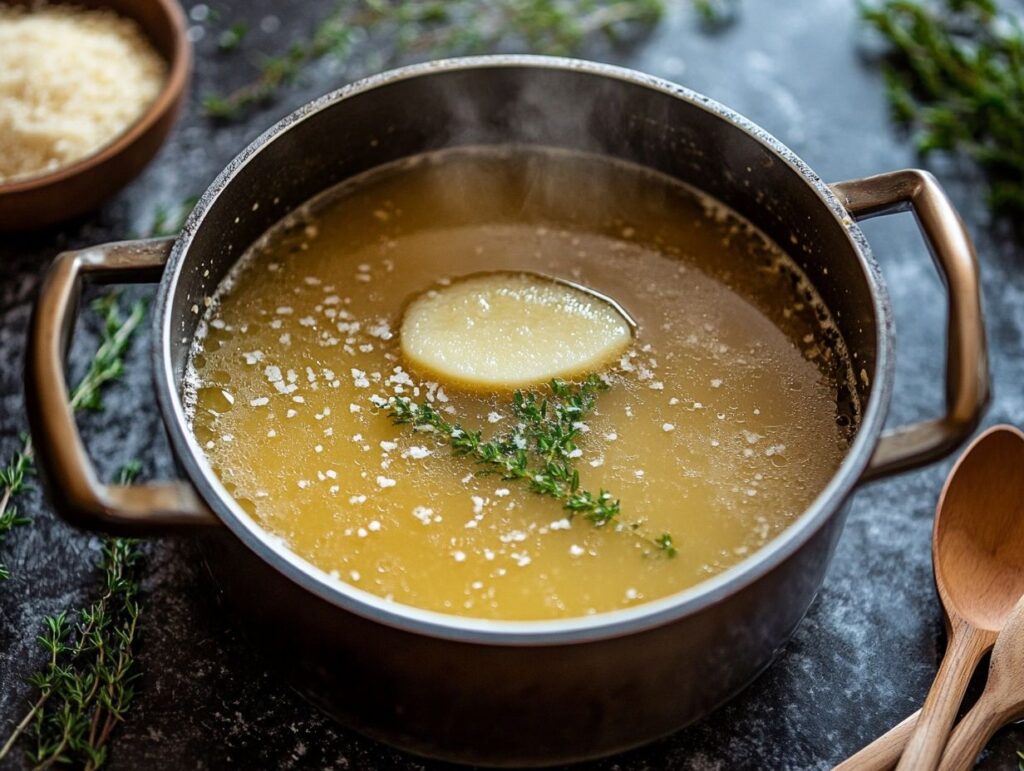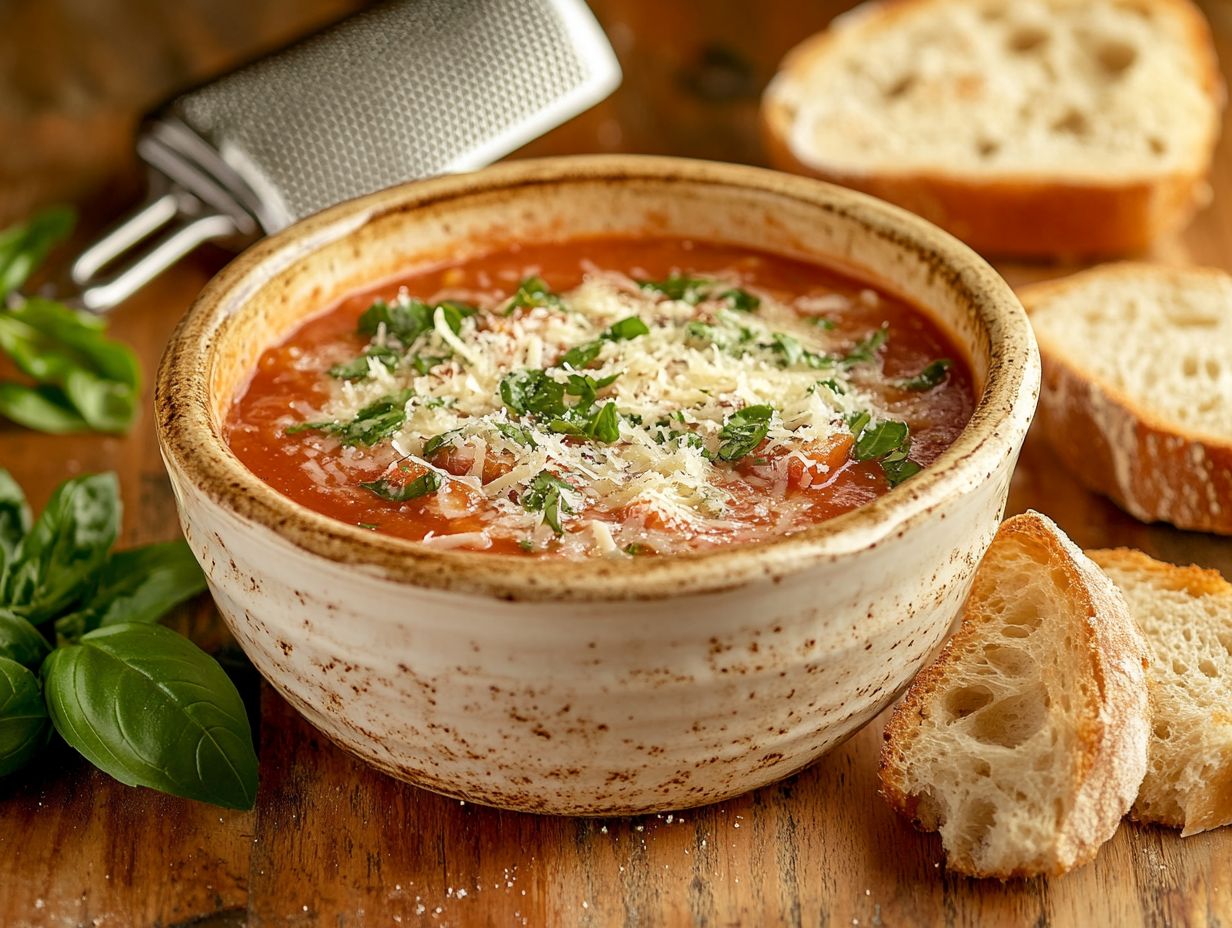Parmesan cheese—just hearing its name conjures thoughts of creamy pasta dishes and savory soups. But have you ever wondered, does Parmesan actually thicken soup? It’s a question many home cooks ask, and the answer lies in understanding both the unique qualities of Parmesan and the art of making soup. Let’s dive deep into this savory subject and uncover the role Parmesan plays in crafting soups with depth, flavor, and texture.
Introduction to Parmesan Cheese and Its Culinary Uses
Parmesan cheese isn’t just a topping; it’s a magic ingredient in the kitchen. Known for its sharp, nutty flavor and crumbly texture, Parmesan—also called Parmigiano-Reggiano when produced in Italy under strict standards—adds an extra dimension to dishes. Beyond grating it over pasta, Parmesan shines as a key player in soups, stews, and broths.
But is Parmesan just a flavor enhancer, or does it serve another purpose? Well, its role goes beyond seasoning. The high fat and protein content make it a versatile addition to recipes that need a little extra body or creaminess.
Understanding the Thickening Process in Soups
What Makes Soups Thick and Creamy?
Think about your favorite creamy soups—potato leek, mushroom bisque, or even classic clam chowder. What gives them that luxurious texture? Thickening soup can involve several techniques:
- Roux: A blend of butter and flour, often used in French cuisine.
- Cream or Milk: Adds richness and a silky consistency.
- Blended Ingredients: Pureeing vegetables or legumes creates natural thickness.
- Cheese: Yes, cheeses like Parmesan can contribute to both thickness and flavor!
So, where does Parmesan fit in? It may not be as obvious as a roux, but it has a surprising impact on soup consistency.
The Role of Cheese in Soup Recipes
Cheese isn’t just about taste; it’s also about chemistry. The proteins in cheese can bond with other elements in a soup, creating a slightly thicker texture. Parmesan stands out because of its concentrated flavor and ability to melt just enough to integrate seamlessly into the broth.
Imagine sprinkling grated Parmesan over a simmering pot. As it melts, it releases fat and proteins into the liquid. While it doesn’t thicken like cornstarch or flour, it adds body—a subtle difference that can elevate your soup.
Parmesan Cheese: Composition and Properties
Why Parmesan Is a Popular Ingredient in Soups
What makes Parmesan the go-to choice for soup recipes? First, it’s all about the flavor. Parmesan’s bold, umami-packed profile can turn even a simple vegetable soup into something extraordinary.
Second, Parmesan’s texture is ideal for melting just enough without becoming gooey or stringy (like mozzarella). Instead, it disperses evenly, creating a velvety layer of goodness in your soup.
“Parmesan cheese isn’t just an ingredient; it’s a secret weapon for turning everyday recipes into something unforgettable.”
Nutritional Profile of Parmesan Cheese
Did you know that Parmesan cheese is packed with nutrients? A small amount provides:
- Protein: Builds and repairs tissue.
- Calcium: Supports strong bones and teeth.
- Fat: Adds richness and satiety to dishes.
In soup recipes, even a modest amount of Parmesan can enhance flavor while contributing to your nutritional intake.
How Parmesan Cheese Interacts with Soups
Does Parmesan Add Thickness or Just Flavor?
Here’s where things get interesting. Parmesan doesn’t thicken soup in the traditional sense like a roux or cornstarch slurry. Instead, its proteins and fats emulsify into the liquid, creating a sensation of creaminess and depth.
For example, adding grated Parmesan to a minestrone soup won’t turn it into a chowder, but it will make the broth taste richer and feel slightly thicker on your palate.
Scientific Explanation of Parmesan’s Thickening Effect
Let’s geek out for a second. Parmesan is rich in casein proteins, which break down when exposed to heat and combine with the soup’s liquid. This interaction is why Parmesan enhances the body of a soup.
Additionally, Parmesan contains tiny fat globules that disperse in the broth, adding a silky texture. While it’s not thickening in a conventional sense, it tricks your taste buds into thinking the soup is creamier than it actually is.
Methods to Use Parmesan Cheese in Soups
Grated Parmesan vs. Shredded Parmesan
Not all Parmesan is created equal, especially when it comes to soup-making. Grated Parmesan dissolves quickly, making it perfect for broths. Shredded Parmesan, on the other hand, melts more slowly, adding a chewy texture.
Pro tip: Use freshly grated Parmesan for the best flavor and melting consistency. Pre-grated options often contain anti-caking agents that can affect the texture of your soup.
Using Parmesan Rinds for a Subtle Thickening Effect

Here’s a hack for Parmesan lovers: don’t throw away the rind! The tough, outer edge of Parmesan cheese is packed with flavor. Toss it into your soup while it simmers, and it will slowly release its essence.
The rind won’t melt completely, but it will infuse the broth with depth and a touch of creaminess. Once your soup is done, just fish it out and discard it.
H3: Blending Parmesan for a Creamy Texture
If you’re aiming for an ultra-smooth soup, consider blending Parmesan directly into the mix. This works especially well for creamy soups like tomato or butternut squash. The cheese emulsifies into the liquid, enhancing both texture and flavor.
“A pinch of Parmesan can transform a good soup into a great one—it’s like a culinary cheat code!”
Common Issues When Using Parmesan in Soups
Using Parmesan cheese in soups sounds like a no-brainer, right? But even the most seasoned cooks run into occasional hiccups. Parmesan is a star ingredient, but it has its quirks. Let’s troubleshoot some common problems so you can harness its full potential without any culinary catastrophes.
Why Parmesan Sometimes Clumps in Soup
You’ve sprinkled Parmesan into your soup, expecting it to dissolve like magic. But instead, you get a lumpy mess. What’s going on? The culprit is usually temperature. Parmesan melts best in a gentle, consistent heat. If your soup is too hot, the cheese proteins coagulate, forming clumps rather than blending smoothly.
How to fix it? Lower the heat before adding Parmesan and stir continuously. This encourages the cheese to integrate seamlessly with the liquid.
How to Prevent Parmesan from Overwhelming the Flavor
Parmesan is bold—too bold sometimes. Adding too much can overpower the delicate flavors of your soup, turning it into a one-note dish.
To keep your flavors balanced, start with a small amount (a tablespoon or two), taste as you go, and adjust accordingly. Remember, you can always add more, but it’s tricky to dial it back once it’s in.
Dealing with Parmesan’s Salty Nature
Parmesan is naturally salty, so it’s essential to adjust the seasoning in your soup carefully. Always taste your soup after adding Parmesan before reaching for the salt shaker. A heavy hand with the cheese can make your soup too salty to enjoy.
Pro tip: Use low-sodium broth or water as your soup base to give Parmesan room to shine without tipping the salt balance.
Alternative Ingredients for Thickening Soups
While Parmesan cheese is a fantastic option, it’s not the only player in the soup-thickening game. Whether you’re out of Parmesan or catering to dietary restrictions, plenty of alternatives can deliver the creamy texture you crave.
Comparing Parmesan with Cream, Flour, and Starch
Each thickening agent has its own unique effect on soup. Here’s how Parmesan stacks up:
| Ingredient | Effect | Best Use |
|---|---|---|
| Parmesan Cheese | Adds subtle body and bold flavor | Broth-based or light creamy soups |
| Heavy Cream | Creates a rich, smooth texture | Chowders or bisques |
| Flour (via Roux) | Thickens with a neutral flavor | Hearty stews or gravy-like soups |
| Cornstarch | Quick, clear thickening without added flavor | Asian-inspired soups or light broths |
Parmesan is unique because it thickens while adding a punch of umami—a dual purpose other thickeners can’t replicate.
Non-Dairy Options for Thickening Soups
Need a dairy-free option? You can still achieve a creamy texture without Parmesan. Consider these alternatives:
- Coconut Milk: A rich and creamy substitute perfect for Asian or Caribbean soups.
- Blended Nuts (e.g., cashews): Soaked and blended cashews mimic the creaminess of cheese beautifully.
- Pureed Vegetables: Blending ingredients like potatoes, cauliflower, or squash thickens the soup naturally.
Creative Soup Recipes with Parmesan Cheese

Now that you know how to use Parmesan effectively, it’s time to put that knowledge to good use. These recipes showcase Parmesan as a key ingredient, enhancing both flavor and texture in delicious ways.
Parmesan Potato Soup
This hearty recipe combines the creamy comfort of potatoes with the sharp, nutty flavor of Parmesan. Here’s how to make it:
- Sauté onions and garlic in butter.
- Add diced potatoes and chicken broth, then simmer until the potatoes are soft.
- Blend the soup until smooth, stir in heavy cream, and finish with a generous handful of grated Parmesan.
The result? A velvety, cheesy soup that’s perfect for chilly nights.
Creamy Tomato and Parmesan Soup
Tomato soup is a classic, but Parmesan takes it to the next level.
- Start with roasted tomatoes for a rich, smoky base.
- Simmer them with onions, garlic, and vegetable broth.
- Blend until smooth, then stir in Parmesan for a creamy, umami-packed finish.
Serve it with grilled cheese sandwiches for the ultimate comfort meal!
H3: Parmesan Broth for Light Soups
If you prefer lighter soups, Parmesan broth is a game-changer. Simply simmer Parmesan rinds with water, garlic, and herbs to create a flavorful base. Use this broth to make delicate soups like vegetable medleys or tortellini soup.
“Recipes are like stories, and Parmesan is the plot twist that makes the tale unforgettable.”
Frequently Asked Questions About Parmesan in Soups
Can you freeze soups with Parmesan cheese?
Yes, but with a caveat. Soups with Parmesan cheese can be frozen, but the texture may change slightly upon reheating. Parmesan can become grainy when frozen, especially if it’s used in a creamy soup. To avoid this, consider adding the Parmesan after reheating, rather than freezing it with the soup.
Pro tip: If you must freeze a soup containing Parmesan, reheat it gently over low heat and whisk vigorously to restore its creamy texture.
How much Parmesan is too much in a soup?
This depends on the soup’s flavor profile and your personal preference. As a general guideline, start with 1-2 tablespoons of grated Parmesan per serving. Taste as you go, and remember that Parmesan is naturally salty.
Too much can overpower the dish, but just the right amount enhances its richness without stealing the spotlight.
Can you use pre-grated Parmesan in soups?
While convenient, pre-grated Parmesan often contains anti-caking agents that can affect the texture and flavor of your soup. For the best results, use freshly grated Parmesan. The difference in taste and melting quality is worth the extra effort.
What’s the best way to store Parmesan cheese?
Parmesan should be stored in the refrigerator, tightly wrapped in wax paper or parchment paper, followed by aluminum foil. This method keeps it fresh and prevents it from drying out. For long-term storage, you can freeze Parmesan rinds for use in soups and broths.
Is Parmesan suitable for lactose-intolerant individuals?
Good news! Parmesan cheese is naturally low in lactose due to its aging process. Most people with lactose intolerance can enjoy Parmesan without any issues. However, always check with your doctor if you’re unsure.
What dishes pair well with Parmesan-thickened soups?
Parmesan-thickened soups are versatile and pair well with crusty bread, garlic toast, or simple side salads. These accompaniments enhance the meal without overpowering the delicate flavors of the soup.
Conclusion: Does Parmesan Truly Thicken Soup?
So, does Parmesan thicken soup? The answer is yes—though not in the traditional sense. While it doesn’t create a roux-like consistency, Parmesan enhances the soup’s texture by adding a creamy body and a rich, umami flavor.
Whether you use grated cheese, shredded pieces, or even the humble rind, Parmesan has the ability to transform ordinary soups into culinary masterpieces. By understanding its properties and using it wisely, you can elevate your cooking game and impress even the pickiest eaters.
Related Recipes and Inspiration
Creamy Parmesan Italian Sausage Soup – A relevant article showcasing how Parmesan enhances creaminess in soups.
Best Sandwich for Potato Soup – Discuss pairing thickened soups like potato soup with complementary sides.
Black Pepper and Parmesan Soufflé – Highlighting Parmesan’s role in thickening and enriching other dishes.

